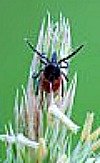LIKE us AT Facebook! Share and learn tips, techniques, gear and more!
Information on :
Tick Removal,
Types of Ticks and
Tick Bites.
Learn proper tick removal technique to prevent Lyme disease from tick bites, and what types of ticks carry Lyme disease and their distribution.
Deet Insect Repellent – Treating Mosquito Bites – Mosquito Info – Identify Biting Insects - Natural Insect Repellents
My experience with ticks.
When I would guide canoe trips, one of my campers had said that another leader had told them that ticks looked like dragonfly larvae- (a very large insect). She said she was terrified of ticks. Then, the leader showed a picture of an actual tick, and they suddenly didn’t seem so large, scary or intimidating. If you want to prank younger campers, this is a great way to do it!!! I know I used this technique after on new campers.
Background information on Ticks:
Ticks. What can I say, these are absolutely disgusting. I don’t have many fears of insects or creepy crawlies, but these top the cake for me! They look similar to a tiny spider who’s body has been flattened, and in fact, they’re more closely related to a spider or scorpion than an insect.. The females burrow their head under your skin and then suck your blood. This is usually painless as their saliva has a numbing agent. Once their head is in your skin, the female tick will remain there until their body is swollen. Often, a smaller male tick will have found her and attached to her body and will hang out with the female tick. Once her body is engorged with blood, she will then will fall off and then lay her eggs.
Ticks are usually encountered in the spring-time and are found in areas with long grass. The ticks will crawl onto you as you walk past the grass, and then climb around on your body looking for a perfect warm area with thinner skin.
Tick Prevention
Besides not going outdoors, there are a few things that you can do to keep ticks off of your skin.
Tuck your pants into your socks and wear long sleeve shirts.
Apply insect repellents to clothes.
Wear light coloured clothes so you can see the ticks against your clothes.
Do nightly ‘tick checks’ on your camping buddies and yourself.
Have pets treated with treatments for fleas and ticks.
If you have a dog, give it a nice rub, and find any ticks on its body.
Tick Removal :
For tick removal, you need tweezers. Slide the tweezers around near the head of the tick. Pull in the direction that the tick is in. Twisting and turning will not help it to come out as the mouth is barbed. For full tick removal, be careful not to leave the head in, or squeeze the body. If the head remains inside after tick removal, it can get infected. Once it the tick is removed, they are not easy to kill. I once stabbed one with a sharp fork, and it’s legs were still wiggling two days later! YUK! I find the best way to kill ticks after tick removal is to cut them in half, however it is not recommended to squish them as this might transmit pathogens. During tick removal, if you squeeze the body, they may spit or ‘throw up’ inside your body passing on Lyme disease if they have it. The recommended disposal method is to flush down a toilet, or keep it in a tight jar or ziploc bag with a damp cotton ball to keep it alive for identification and testing purposes if you do become ill from the tick bites.
Once you’ve removed the tick, make sure to wash the area with soap and water, and make sure to keep an eye on the area for signs of infection.
Ticks and Lyme Disease:
Some types of ticks carry (are a vector for) Lyme disease and many other diseases, a potentially serious disease. This is spread when their guts are spewed into your blood stream. Early symptoms include: fever, headache, fatigue, depression and circular skin rash. If treated early, it can be cured by antibiotics, if left untreated it can become impossible to treat and debilitating.
If after being bitten by a tick, and you’ve removed it, and a red bulls eye rash forms around the tick bites, you may have Lyme disease. Make sure that you inform your doctor of the fact that you have been bitten by a tick, so that they can treat you properly.
Map of areas in Canada that have Lyme disease.
Map of areas in the USA with Lyme disease. - Lyme disease is found in the northeast and upper Midwest regions of the USA.
Map of areas of Europe with Lyme disease.
Types of Ticks (and which types of ticks carry Lyme disease)
Although all types of ticks carry diseases, most ticks do not harbour any illnesses or diseases and are a harmless (although gross) bite.

Deer Tick / Black Legged Tick
Location: This tick is found in Manitoba and all provinces east of Manitoba including Quebec, Ontario and Atlantic provinces.
Appearance: Black legs and brown body. A small tick.
Vector: Lyme disease if the area is known to have Lyme disease
Human Granulocytic Anaplasmosis - some symptoms include fever, rash, headache.
Western Black Legged Tick
Location: British Columbia and Pacific coast, most common in area of southern British Columbia near the Fraser delta and Gulf and Vancouver island.
Appearance: Similar to Deer tick/ black legged tick.
Vector: Lyme disease if the area is know to have Lyme disease
Human Granulocytic Anaplasmosis – some symptoms include fever, rash, headache.

American Dog tick
Location: Saskatchewan east to maritime provinces, and the Eastern United States. Very common tick.
Appearance: Light Brown body and brown legs. Body of unengorged tick has white on back. Engorged tick has a slate-grey colour.
Host: Prefer to feed on dogs.
Vector: Tularemia (rabbit or deerfly fever). Tick paralysis. Once tick is removed, paralysis should stop. Rocky mountain Spotted fever.
Rocky Mountain Wood Tick
Location: Arid locations of Southern Saskatchewan westward to the coast and upt to the Yukon.
Appearance: similar to American Dog tick
Vector: Rocky Moutnain Spotted Fever, involved with tick paralysis (in USA).
Brown Dog tick
Location: Locations in all of North America except Alasca and the Canadian Territories. provinces and North America. Very common along pacific coast.
Appearance: Uniformly darker red-brown body and legs.
Host: Usually attaches to dogs only, usually on the ears and between the toes.
This tick cannot over winter, so in northern regions, it usually winters inside homes.
Vector: rarely the rocky mountain spotted fever.

Lone Star Tick
Location: Smallest distribution. Small numbers found in Southern Ontario and Southern Quebec – along the St. Lawrence area.
Appearance: Darker brown. Unengorged has longer legs. Adult has white spot on middle of back.
Vector: Human Monocytic Ehrlichiosis - some symptoms include fever, rash, headache.
Most ticks are harmless and tick bites shouldn’t scare you from enjoying the outdoors.
Some articles that you might be interested in:
Identify all the biting creepy crawlers
Natural Insect Repellents and recipes
Deet Insect Repellent – pros and cons to this neurotoxin
Information on diseases mosquitos carry and mosquito spray
Tick Removal and information on ticks
Return from Insect Natural Insect Repellent to Camping Expert (home)







New! Comments
Have your say about what you just read! Leave me a comment in the box below.